SEO
17 Actionable Marketing Tips (That You Can Apply Right Away)

Looking for simple yet effective marketing tips? You’re in the right place.
Here’s a list of 17 marketing tips that you can implement right away.
Someone on LinkedIn offers you 64 ChatGPT prompts to improve your content marketing. You download the PDF and tell your marketing team members they need to get on those now.
You then hop on Twitter and see someone share the MrBeast formula for YouTube. You don’t even have a YouTube channel, but you’re convinced—you need a YouTube strategy right now.
But here’s the thing: Chasing every new tactic that falls on your lap is derailing your marketing.
Avoid shiny object syndrome and focus only on tactics that advance you toward your #1 marketing objective. Be honest with yourself. If you don’t see how they help, don’t do them. You can always save them for next time.
The success of Mark Zuckerberg can be attributed to his hyperfocus:
If you find that your marketing is dispersed in all directions and getting no results, chances are you’re trying to chase too many marketing goals at once.
Simplify your focus. Commit to one marketing goal. And make sure it’s SMART too:
- Specific – Clearly state the desirable outcome and explain who, what, when, how much, etc.
- Measurable – Track progress with key performance indicators (KPIs).
- Achievable – Set bold goals, but also be realistic; use the current growth as a benchmark.
- Relevant – Does the objective align with your overall marketing and business strategy?
- Timely – Set up a time frame for achieving the goal.
You’re likely not the only business selling your product or service. So why should anyone choose you over the rest?
If you don’t tell them why, they won’t.
That’s why your positioning should make it crystal clear to potential customers what your product or service is, why it’s different, and why it matters to them.
How do you create your positioning statement? The best way is to follow April Dunford’s “Obviously Awesome” framework. I highly recommend buying the book, but here’s a quick summary:
- Understand who your best customers are
- Form a positioning team and align your positioning vocabulary across teams/departments
- List your competitive alternatives
- Figure out the attributes and features that make your product/service unique
- Figure out the true value of these attributes and features—what do they do for your customers?
- Find a target market that makes your value obvious to the customer segments that care most about your unique value proposition
- Capture your positioning in an evergreen document that can be shared across all teams
You may have a significant following on social media, but:
When it comes to developing an audience, there’s no better way than to build an email list. It may be a relic on the internet timeline, but it’s reliable—with an email list, you own the contact details and can communicate with your audience anytime.
To build an email list, you must convince website visitors to subscribe. Most websites offer something in return for subscribing—a free ebook, a course and, sometimes, a discount.

At Ahrefs, we have a simple opt-in form on our blog:
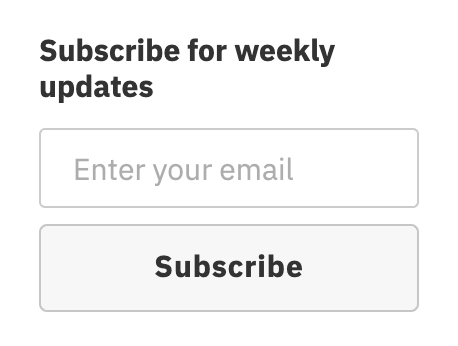
The moment your audience signs up for your email list, they’ll likely receive a welcome email. For example, this is what our email looks like:

Your welcome email sequence can be one or more emails. But how do you know what kind of emails you should send?
It all depends on your guiding narrative. This is the high-level message you think will resonate with your audience. Basically:
What do you want your audience to take away from your email sequence?
For example, if you sell Italian food in London, your narrative could be:
- The recipes you use in your restaurant are passed down from your great-grandfather’s generation.
- All the ingredients are shipped fresh from Italy.
- Your restaurant has one Michelin star.
For us at Ahrefs, we decided that:
- We want to showcase our content since it is both educational and product-led.
- All we need is one email to share our best blog posts.
That’s how we came up with our welcome email.
Here’s an article listing the best cafes in London:

If we plug this page into Ahrefs’ Site Explorer, we see that it gets an estimated 3,800 visits from search engines each month:

If there are any relevant lists like this for your business, you’ll want to be on them. You can find relevant lists with traffic using Ahrefs’ Content Explorer:
- Enter a relevant search (i.e., “best [business type] [local area]”)
- Select In title from the dropdown
- Run the search
- Set the Live & broken filter to Only live
- Add a Page traffic filter and set the minimum to 100
- Check Exclude homepages

Giveaways are a great way to simultaneously build brand awareness and your email list. But many marketers make the mistake of giving away things utterly unrelated to what they do, like an iPhone or iPad.
They then wonder why none of the people they attract turn into paying customers.
For sweepstakes to work, you must give away something that attracts potential customers. Your product is the most obvious choice, but don’t limit yourself to that.
For example, when I worked for a burgeoning startup years ago, I partnered with another company to give away its product. We then shared the email list between us.

At Ahrefs, we regularly give away our swag.
Look at how happy they are:
The first step is to create or claim your Google Business Profile (GBP). But that’s not enough. You’d want to optimize it so that you’ll appear on Google when searchers are looking for businesses that offer things or services they need.
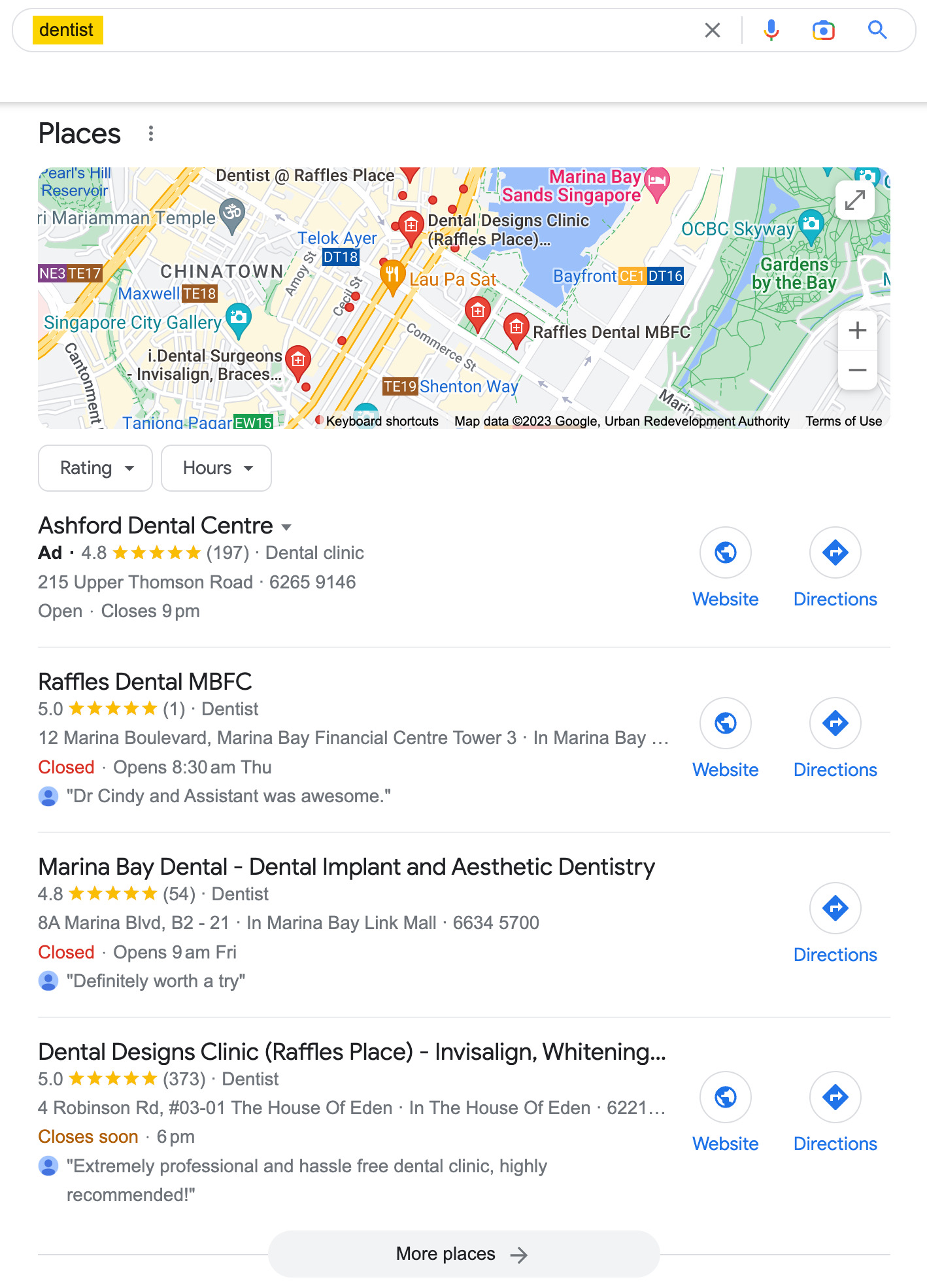
Here’s how to optimize your GBP:
- Business categories – You can help Google understand your business better by selecting up to 10 business categories. It’s also a good idea to keep abreast of the new categories that Google adds so you can update your GBP accordingly.
- Attributes – These can be thought of as labels or tags that convey additional information about the business. Some are objective (e.g., “black-owned [business]”) and thus can be controlled by you. Others are subjective and are earned when a certain feature of your business is often suggested by the customers.
- Reviews – This is beyond GBP itself, but you’d want to provide a great experience for your customers so they’ll leave good reviews. You should also ask for it when you have the opportunity—usually when the customer expresses their satisfaction, whether they say it personally or online.
Did you know that 90.63% of pages get zero traffic from Google?

It is likely because they’re not targeting topics that people are searching for.
It makes sense: If nobody searches for what you’re writing about, you won’t get search traffic. So if you want passive, consistent traffic coming to your site, you’ll have to target topics with search traffic potential.
How do you find these topics?
- Go to Ahrefs’ Keywords Explorer
- Enter one or a few relevant terms
- Go to the Matching terms report
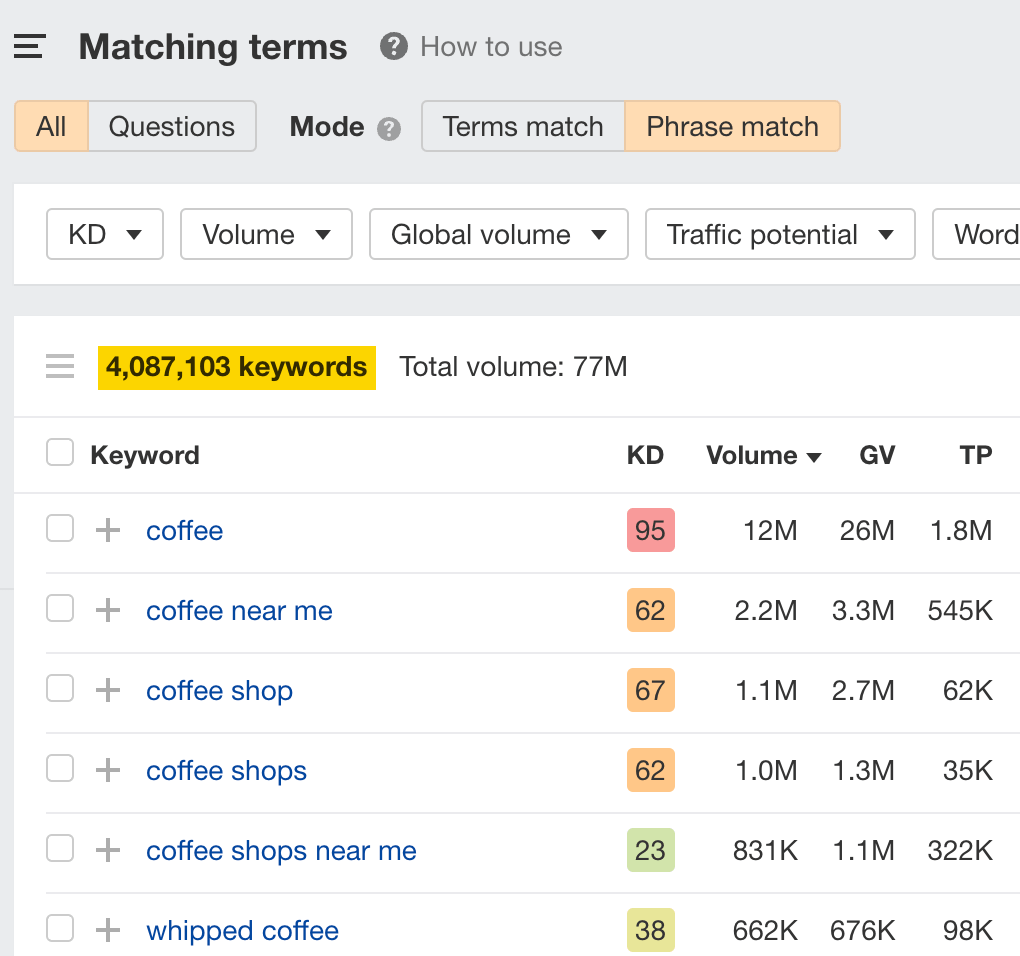
You’ll see over 4 million potential keywords to target. You can narrow the list by focusing on low-competition topics with traffic potential.
Just add these filters:
- Traffic Potential to >500
- Keyword Difficulty to <20
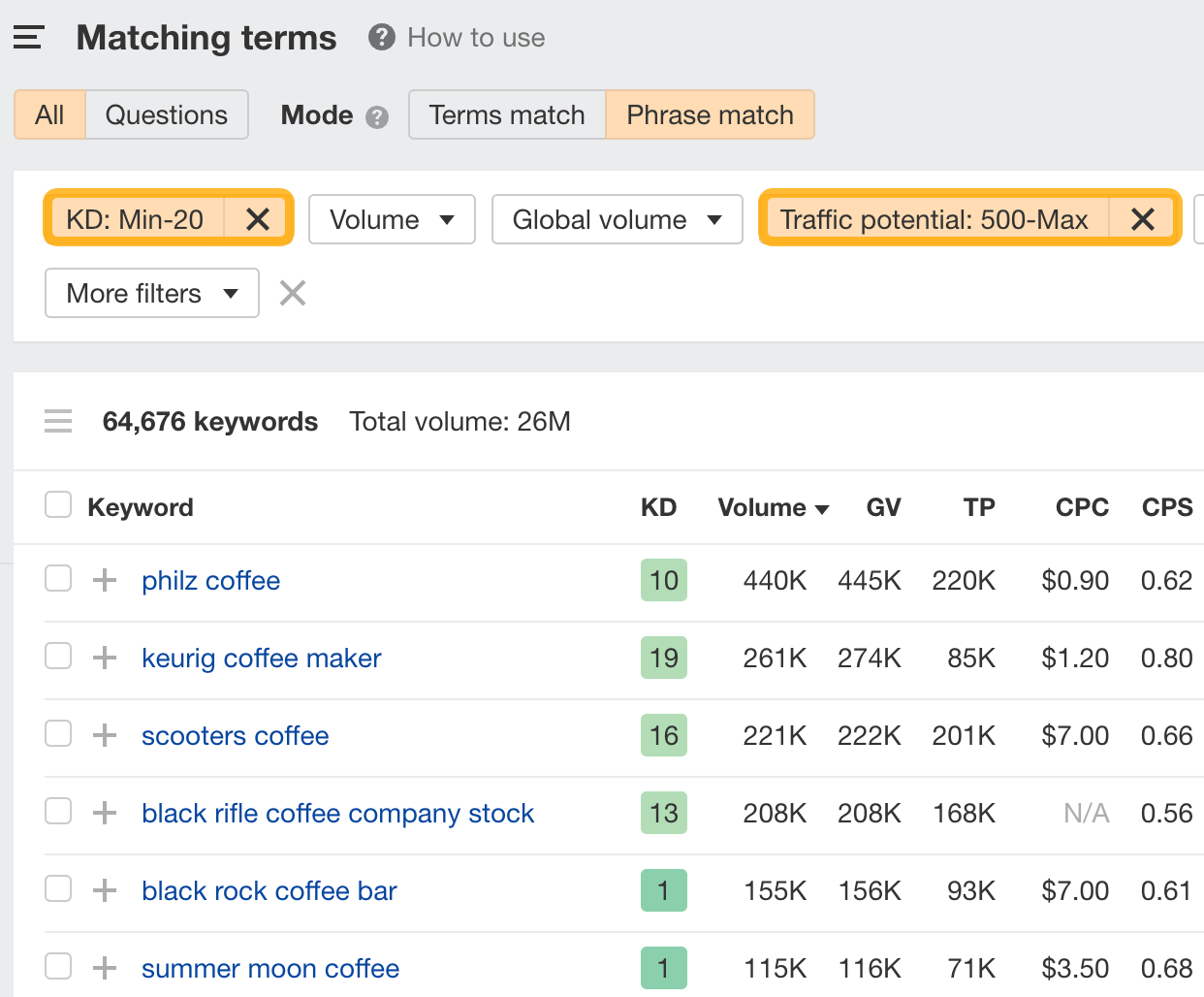
Go through the results and pick out relevant ones for your site.
Generally speaking, the more high-quality links you have, the higher your page will rank.

So if you spot a page that doesn’t have many backlinks but still ranks high on Google, it means you can potentially outrank it. Here’s how we can find these opportunities:
- Go to Ahrefs’ Content Explorer
- Enter a relevant keyword
- Set a Referring domains filter to max. 10
- Set a Page traffic filter to min. 500
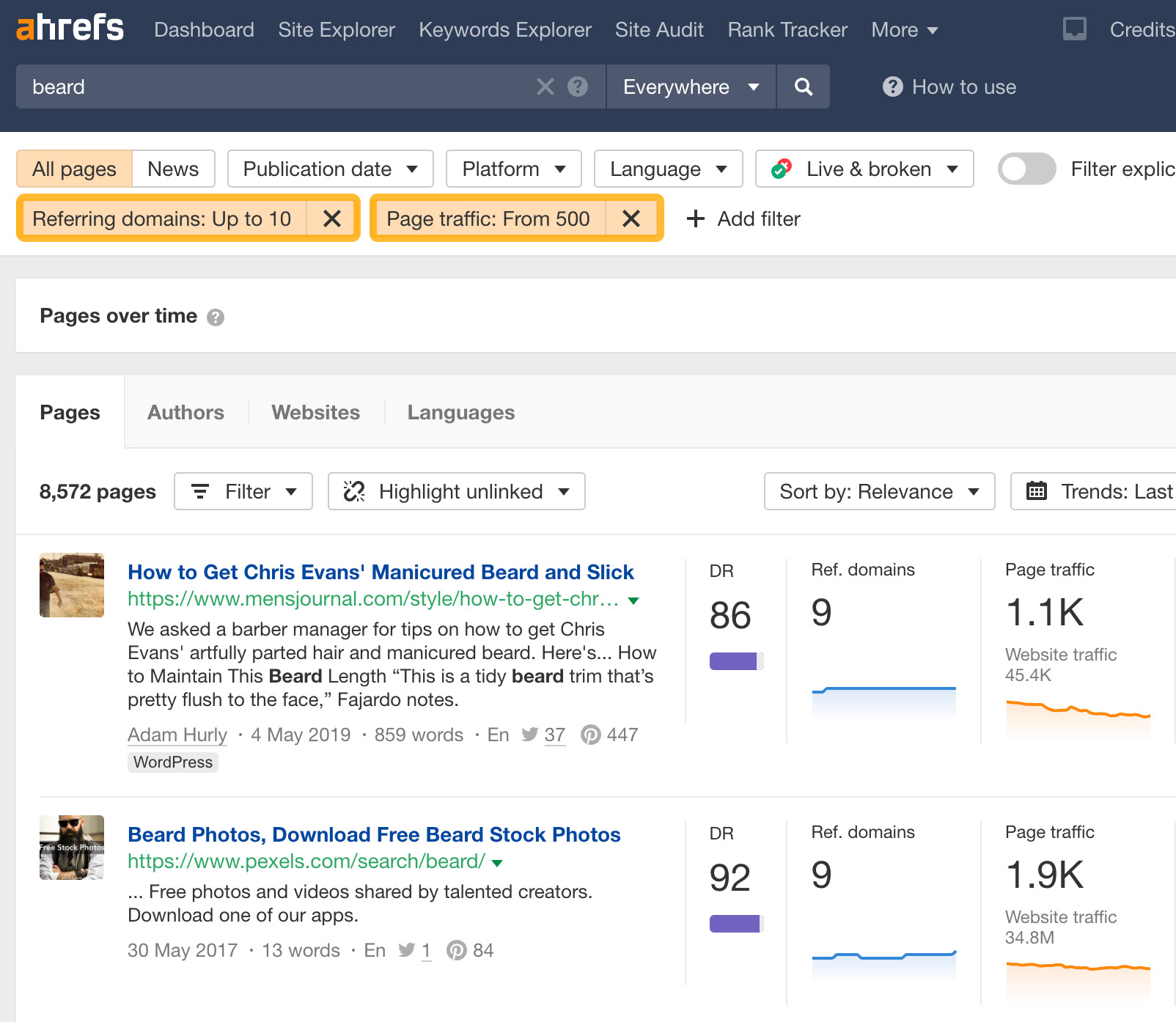
Click Details and then the Organic keywords tab to see which topics those pages are ranking for.
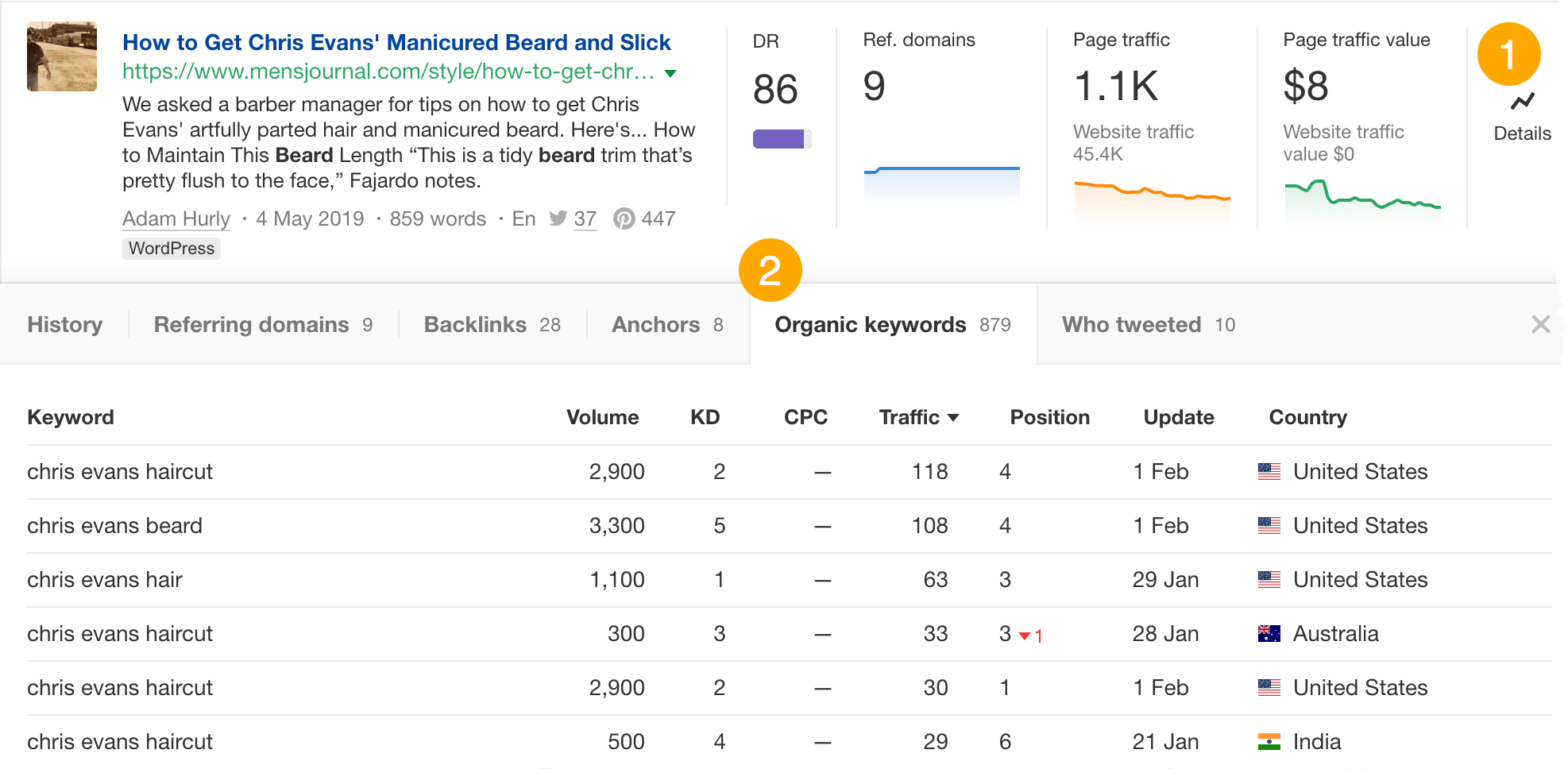
They could be potential keywords to target too.
When it comes to paid advertising, everyone’s go-tos are Facebook, Instagram, and Google Ads. But don’t forget that other social platforms like Twitter, Quora, and TikTok have advertising too.
Especially Quora.
Even though it’s overshadowed by other platforms, it still boasts 300 million monthly visitors for now. And we’ve seen great results from Quora ads.
Not only is it generally cheaper than other PPC platforms, but it also has great targeting options:

How can you get the best out of this platform? I’ll leave the explanation to my colleague, Michal Pecánek, who has been running our ads on Quora. Check out his guide:
There are 3 million active podcasts. Many of them are interview-based and are constantly looking for new guests.
Why not pitch yourself to them? You’ll get exposure to a new audience and a link back to your site.
Here’s how to find podcasts:
- Identify a prolific podcast guest in your industry
- Plug their website’s homepage into Ahrefs’ Site Explorer
- Choose Exact URL
- Go to the Backlinks report
- Search for “episode” in the Referring page title
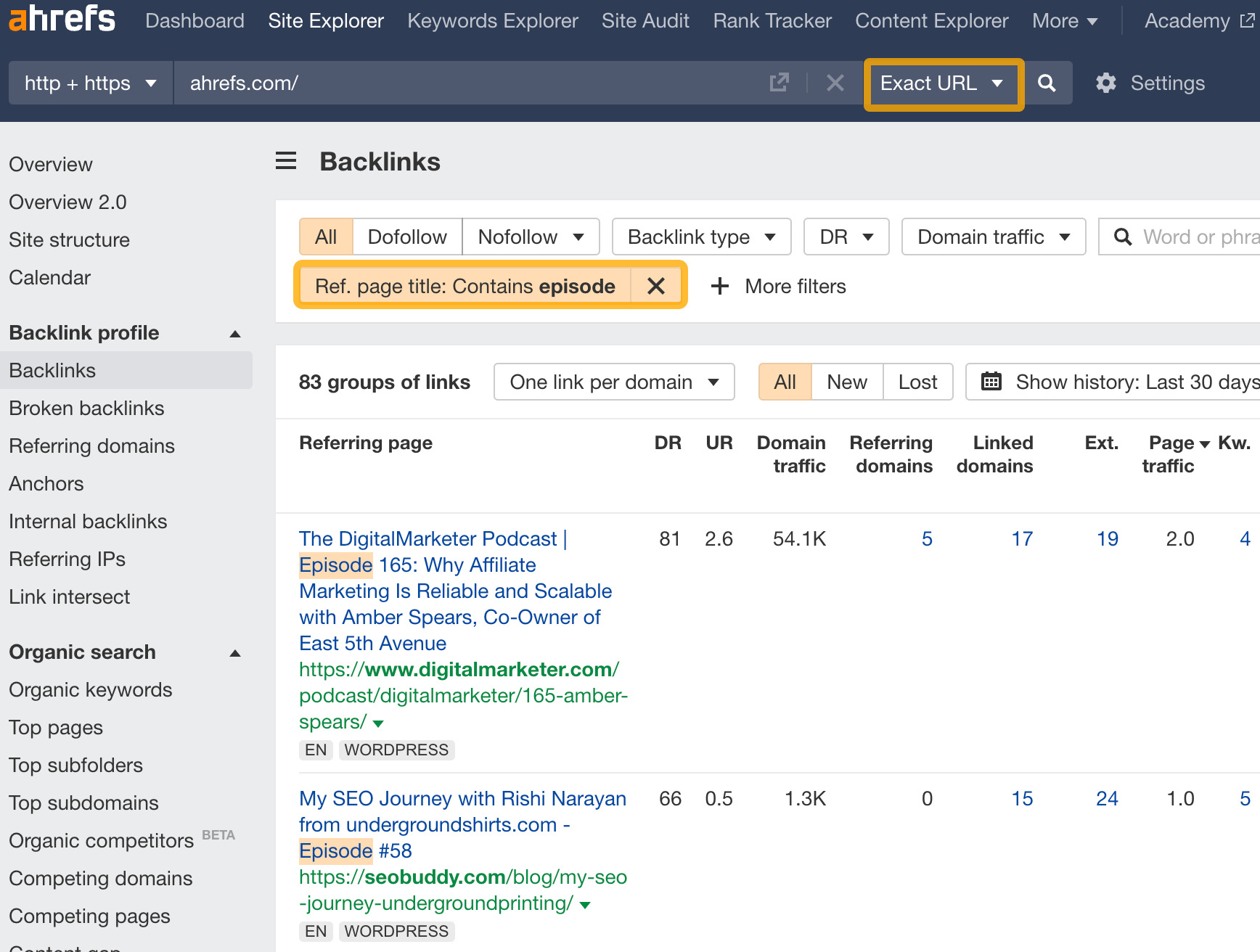
Go through the list and pick out podcasts you could appear on. Pitch yourself to them.
Make your content go the extra mile by turning it into Twitter threads. This can be as simple as pasting your articles into Typefully and editing them to fit Twitter’s requirements.
Here’s an example of how we did it:
But you’d want as many people as possible to see your thread. How do you do that? It’s a little meta, but learn how to craft a top 1% Twitter thread from this Twitter thread:
Created an amazing Twitter thread that generated tons of attention? Don’t stop there—push it even more by turning your thread into a LinkedIn carousel.
A carousel is a format that allows you to add multiple images and/or videos in a single post. Here’s an example of a Twitter thread turned into a carousel:
Note that this feature may not have been rolled out to everyone yet. But don’t worry. You can always create a PDF and upload it. Here’s an example of how we did it:
Sidenote.
In fact, the carousel was created by LinkedIn in response to its users uploading PDFs to show multiple images.
Sometimes, all it takes is to show up at events where your customers are hanging out. That way, you can meet them in person, build up a relationship, and they may eventually become your customers.
Especially if you’re a local business, tight-knit and small local meetups are great places to meet prospective customers. If you have the budget, you can even sponsor the event by providing light bites or drinks.
Even better: volunteer to speak at the event. It can help build brand awareness, boost your status as a thought leader, and, most importantly, get you customers.

No niche events in your local area? Then step up and take the responsibility to run one.
We did this a few months ago, and it went really well.
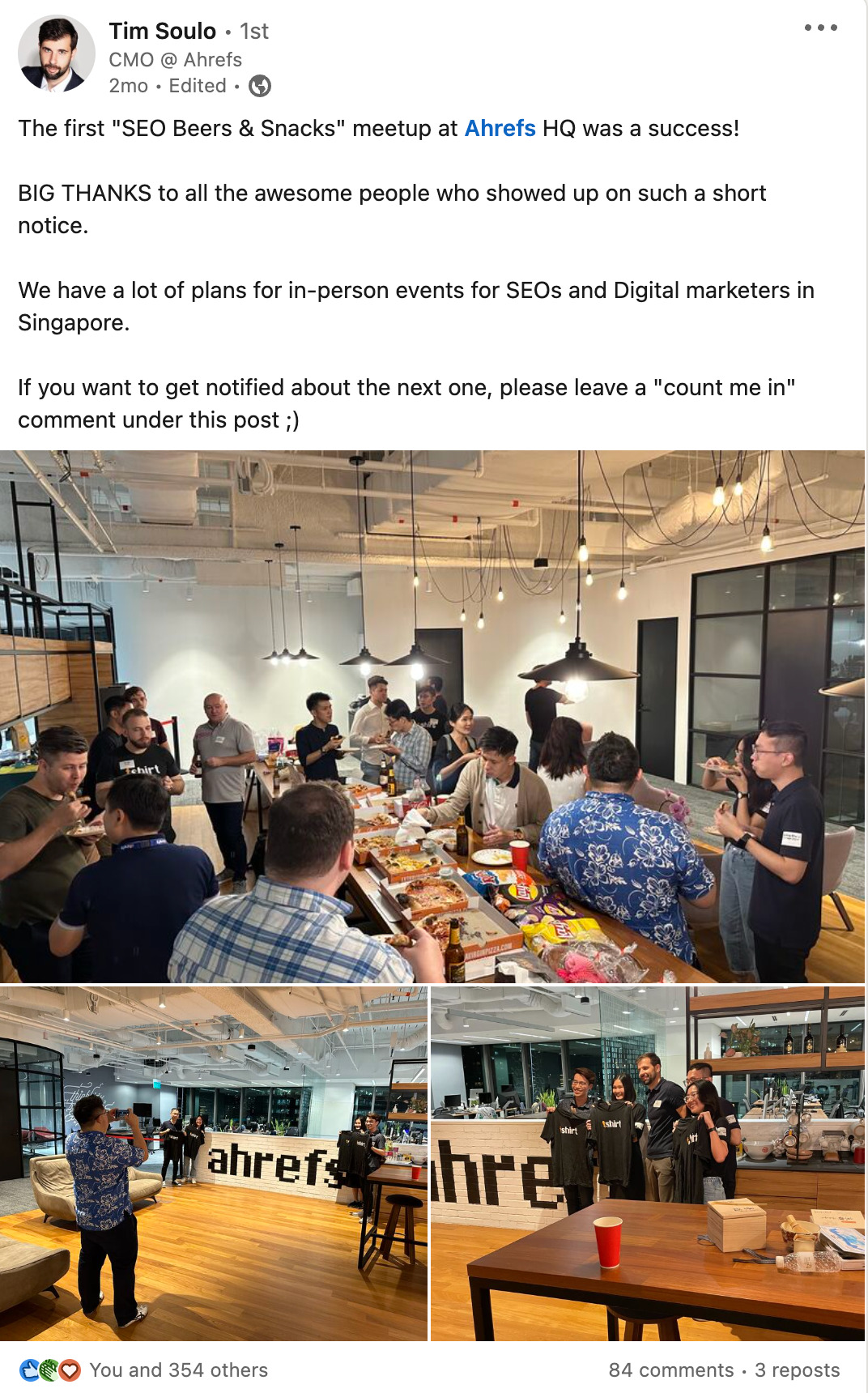
Don’t look down on small events—it’s usually the seed of bigger things in the future. As you can see, only around 15 people turned up that day. But it has already generated interest both online and via word of mouth. (And we’re ready to scale it up!)
Many people think social media is about posting as much as possible. But nothing can be further from the truth.
After all, if you don’t have an existing audience, you’re publishing to crickets. So to kickstart your social media growth, you have to practice good reply game.
How do you do that? I asked marketing consultant David Fallarme, and here’s what he said:
For most people going from zero to one on LinkedIn, the way to get engagement on your content is to give engagement to other content first.
Your first job: to find and add people who are relevant to you and your target audience. Add a few influencers in your niche, then use the “People also viewed” function to see who else LinkedIn suggests. These are typically people who post regularly, which means you’ll be exposed to a lot of content in your niche.
After following ~10–15 influencers, you should build your LinkedIn writing muscle by commenting on their posts whenever you log on. This does a couple of things: First, it trains your brain that posting on LinkedIn is nothing to be scared of. Two, it gives you new ideas for your own content—every comment you leave is the seed for future posts. Third, when you leave thoughtful comments, and when you reply to others who have left comments, others who also follow that person will visit your profile and respond to your connection requests.
All of these increase the chances that when you post something on LinkedIn, it’s relevant to your target audience and you’re not just yelling into the void. You always have new connections who are exposed to your content.
Sidenote.
He was specifically talking about LinkedIn, but his tips can be applied across all platforms.
However, don’t comment for the sake of commenting. The worst thing you can do is become a “reply guy.” You’d want to genuinely participate in the conversation. Add on to their post, give them something new to think about, or challenge their opinion in a friendly way.
That’s how you become memorable within the comment section.
Final thoughts
Now you know my top actionable marketing tips, the next step is to apply them to your own business.
If you get any results using these tips, let me know on Twitter.
SEO
Google Further Postpones Third-Party Cookie Deprecation In Chrome

Google has again delayed its plan to phase out third-party cookies in the Chrome web browser. The latest postponement comes after ongoing challenges in reconciling feedback from industry stakeholders and regulators.
The announcement was made in Google and the UK’s Competition and Markets Authority (CMA) joint quarterly report on the Privacy Sandbox initiative, scheduled for release on April 26.
Chrome’s Third-Party Cookie Phaseout Pushed To 2025
Google states it “will not complete third-party cookie deprecation during the second half of Q4” this year as planned.
Instead, the tech giant aims to begin deprecating third-party cookies in Chrome “starting early next year,” assuming an agreement can be reached with the CMA and the UK’s Information Commissioner’s Office (ICO).
The statement reads:
“We recognize that there are ongoing challenges related to reconciling divergent feedback from the industry, regulators and developers, and will continue to engage closely with the entire ecosystem. It’s also critical that the CMA has sufficient time to review all evidence, including results from industry tests, which the CMA has asked market participants to provide by the end of June.”
Continued Engagement With Regulators
Google reiterated its commitment to “engaging closely with the CMA and ICO” throughout the process and hopes to conclude discussions this year.
This marks the third delay to Google’s plan to deprecate third-party cookies, initially aiming for a Q3 2023 phaseout before pushing it back to late 2024.
The postponements reflect the challenges in transitioning away from cross-site user tracking while balancing privacy and advertiser interests.
Transition Period & Impact
In January, Chrome began restricting third-party cookie access for 1% of users globally. This percentage was expected to gradually increase until 100% of users were covered by Q3 2024.
However, the latest delay gives websites and services more time to migrate away from third-party cookie dependencies through Google’s limited “deprecation trials” program.
The trials offer temporary cookie access extensions until December 27, 2024, for non-advertising use cases that can demonstrate direct user impact and functional breakage.
While easing the transition, the trials have strict eligibility rules. Advertising-related services are ineligible, and origins matching known ad-related domains are rejected.
Google states the program aims to address functional issues rather than relieve general data collection inconveniences.
Publisher & Advertiser Implications
The repeated delays highlight the potential disruption for digital publishers and advertisers relying on third-party cookie tracking.
Industry groups have raised concerns that restricting cross-site tracking could push websites toward more opaque privacy-invasive practices.
However, privacy advocates view the phaseout as crucial in preventing covert user profiling across the web.
With the latest postponement, all parties have more time to prepare for the eventual loss of third-party cookies and adopt Google’s proposed Privacy Sandbox APIs as replacements.
Featured Image: Novikov Aleksey/Shutterstock
SEO
How To Write ChatGPT Prompts To Get The Best Results

ChatGPT is a game changer in the field of SEO. This powerful language model can generate human-like content, making it an invaluable tool for SEO professionals.
However, the prompts you provide largely determine the quality of the output.
To unlock the full potential of ChatGPT and create content that resonates with your audience and search engines, writing effective prompts is crucial.
In this comprehensive guide, we’ll explore the art of writing prompts for ChatGPT, covering everything from basic techniques to advanced strategies for layering prompts and generating high-quality, SEO-friendly content.
Writing Prompts For ChatGPT
What Is A ChatGPT Prompt?
A ChatGPT prompt is an instruction or discussion topic a user provides for the ChatGPT AI model to respond to.
The prompt can be a question, statement, or any other stimulus to spark creativity, reflection, or engagement.
Users can use the prompt to generate ideas, share their thoughts, or start a conversation.
ChatGPT prompts are designed to be open-ended and can be customized based on the user’s preferences and interests.
How To Write Prompts For ChatGPT
Start by giving ChatGPT a writing prompt, such as, “Write a short story about a person who discovers they have a superpower.”
ChatGPT will then generate a response based on your prompt. Depending on the prompt’s complexity and the level of detail you requested, the answer may be a few sentences or several paragraphs long.
Use the ChatGPT-generated response as a starting point for your writing. You can take the ideas and concepts presented in the answer and expand upon them, adding your own unique spin to the story.
If you want to generate additional ideas, try asking ChatGPT follow-up questions related to your original prompt.
For example, you could ask, “What challenges might the person face in exploring their newfound superpower?” Or, “How might the person’s relationships with others be affected by their superpower?”
Remember that ChatGPT’s answers are generated by artificial intelligence and may not always be perfect or exactly what you want.
However, they can still be a great source of inspiration and help you start writing.
Must-Have GPTs Assistant
I recommend installing the WebBrowser Assistant created by the OpenAI Team. This tool allows you to add relevant Bing results to your ChatGPT prompts.
This assistant adds the first web results to your ChatGPT prompts for more accurate and up-to-date conversations.
It is very easy to install in only two clicks. (Click on Start Chat.)
For example, if I ask, “Who is Vincent Terrasi?,” ChatGPT has no answer.
With WebBrower Assistant, the assistant creates a new prompt with the first Bing results, and now ChatGPT knows who Vincent Terrasi is.
 Screenshot from ChatGPT, March 2023
Screenshot from ChatGPT, March 2023You can test other GPT assistants available in the GPTs search engine if you want to use Google results.
Master Reverse Prompt Engineering
ChatGPT can be an excellent tool for reverse engineering prompts because it generates natural and engaging responses to any given input.
By analyzing the prompts generated by ChatGPT, it is possible to gain insight into the model’s underlying thought processes and decision-making strategies.
One key benefit of using ChatGPT to reverse engineer prompts is that the model is highly transparent in its decision-making.
This means that the reasoning and logic behind each response can be traced, making it easier to understand how the model arrives at its conclusions.
Once you’ve done this a few times for different types of content, you’ll gain insight into crafting more effective prompts.
Prepare Your ChatGPT For Generating Prompts
First, activate the reverse prompt engineering.
- Type the following prompt: “Enable Reverse Prompt Engineering? By Reverse Prompt Engineering I mean creating a prompt from a given text.”
 Screenshot from ChatGPT, March 2023
Screenshot from ChatGPT, March 2023ChatGPT is now ready to generate your prompt. You can test the product description in a new chatbot session and evaluate the generated prompt.
- Type: “Create a very technical reverse prompt engineering template for a product description about iPhone 11.”
 Screenshot from ChatGPT, March 2023
Screenshot from ChatGPT, March 2023The result is amazing. You can test with a full text that you want to reproduce. Here is an example of a prompt for selling a Kindle on Amazon.
- Type: “Reverse Prompt engineer the following {product), capture the writing style and the length of the text :
product =”
 Screenshot from ChatGPT, March 2023
Screenshot from ChatGPT, March 2023I tested it on an SEJ blog post. Enjoy the analysis – it is excellent.
- Type: “Reverse Prompt engineer the following {text}, capture the tone and writing style of the {text} to include in the prompt :
text = all text coming from https://www.searchenginejournal.com/google-bard-training-data/478941/”
 Screenshot from ChatGPT, March 2023
Screenshot from ChatGPT, March 2023But be careful not to use ChatGPT to generate your texts. It is just a personal assistant.
Go Deeper
Prompts and examples for SEO:
- Keyword research and content ideas prompt: “Provide a list of 20 long-tail keyword ideas related to ‘local SEO strategies’ along with brief content topic descriptions for each keyword.”
- Optimizing content for featured snippets prompt: “Write a 40-50 word paragraph optimized for the query ‘what is the featured snippet in Google search’ that could potentially earn the featured snippet.”
- Creating meta descriptions prompt: “Draft a compelling meta description for the following blog post title: ’10 Technical SEO Factors You Can’t Ignore in 2024′.”
Important Considerations:
- Always Fact-Check: While ChatGPT can be a helpful tool, it’s crucial to remember that it may generate inaccurate or fabricated information. Always verify any facts, statistics, or quotes generated by ChatGPT before incorporating them into your content.
- Maintain Control and Creativity: Use ChatGPT as a tool to assist your writing, not replace it. Don’t rely on it to do your thinking or create content from scratch. Your unique perspective and creativity are essential for producing high-quality, engaging content.
- Iteration is Key: Refine and revise the outputs generated by ChatGPT to ensure they align with your voice, style, and intended message.
Additional Prompts for Rewording and SEO:
– Rewrite this sentence to be more concise and impactful.
– Suggest alternative phrasing for this section to improve clarity.
– Identify opportunities to incorporate relevant internal and external links.
– Analyze the keyword density and suggest improvements for better SEO.
Remember, while ChatGPT can be a valuable tool, it’s essential to use it responsibly and maintain control over your content creation process.
Experiment And Refine Your Prompting Techniques
Writing effective prompts for ChatGPT is an essential skill for any SEO professional who wants to harness the power of AI-generated content.
Hopefully, the insights and examples shared in this article can inspire you and help guide you to crafting stronger prompts that yield high-quality content.
Remember to experiment with layering prompts, iterating on the output, and continually refining your prompting techniques.
This will help you stay ahead of the curve in the ever-changing world of SEO.
More resources:
Featured Image: Tapati Rinchumrus/Shutterstock
SEO
Measuring Content Impact Across The Customer Journey

Understanding the impact of your content at every touchpoint of the customer journey is essential – but that’s easier said than done. From attracting potential leads to nurturing them into loyal customers, there are many touchpoints to look into.
So how do you identify and take advantage of these opportunities for growth?
Watch this on-demand webinar and learn a comprehensive approach for measuring the value of your content initiatives, so you can optimize resource allocation for maximum impact.
You’ll learn:
- Fresh methods for measuring your content’s impact.
- Fascinating insights using first-touch attribution, and how it differs from the usual last-touch perspective.
- Ways to persuade decision-makers to invest in more content by showcasing its value convincingly.
With Bill Franklin and Oliver Tani of DAC Group, we unravel the nuances of attribution modeling, emphasizing the significance of layering first-touch and last-touch attribution within your measurement strategy.
Check out these insights to help you craft compelling content tailored to each stage, using an approach rooted in first-hand experience to ensure your content resonates.
Whether you’re a seasoned marketer or new to content measurement, this webinar promises valuable insights and actionable tactics to elevate your SEO game and optimize your content initiatives for success.
View the slides below or check out the full webinar for all the details.
-

 PPC6 days ago
PPC6 days ago19 Best SEO Tools in 2024 (For Every Use Case)
-

 MARKETING7 days ago
MARKETING7 days agoEcommerce evolution: Blurring the lines between B2B and B2C
-
SEARCHENGINES5 days ago
Daily Search Forum Recap: April 19, 2024
-
SEARCHENGINES6 days ago
Daily Search Forum Recap: April 18, 2024
-

 WORDPRESS6 days ago
WORDPRESS6 days agoHow to Make $5000 of Passive Income Every Month in WordPress
-

 SEO7 days ago
SEO7 days ago2024 WordPress Vulnerability Report Shows Errors Sites Keep Making
-

 WORDPRESS6 days ago
WORDPRESS6 days ago10 Amazing WordPress Design Resouces – WordPress.com News
-
WORDPRESS7 days ago
[GET] The7 Website And Ecommerce Builder For WordPress
















You must be logged in to post a comment Login